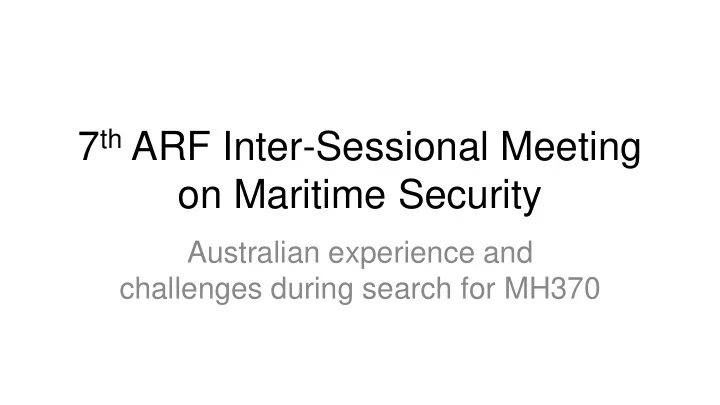

7 th ARF Inter-Sessional Meeting on Maritime Security Australian experience and challenges during search for MH370
Search and Rescue (SAR) in Australia • Joint Aeronautical and Maritime SAR Region (SRR) covering 52.8 million square kilometres = about 10% of the earth’s surface • Obligations to ICAO and IMO for provision of SAR service to civil aviation and maritime/shipping under: – Convention on International Civil Aviation (Chicago Convention) – International Convention for the Safety of Life at Sea (SOLAS) – International Convention on Maritime Search and Rescue (SAR Convention) • Provided by the Australian Maritime Safety Authority (AMSA Search and Rescue) • During 2013-14 AMSA coordinated the search and rescue of 4619 people across 7124 incidents and 506 searches • Australian Defence Force responsible for SAR service to military units/personnel.
Malaysia Airlines Flight MH370: Flight Path derived from Primary and Secondary RADAR data. Source: JIT/Google Earth, ATSB Report.
Possible final positions S4-S5 with 7 th arc and max range cruise line Source: JIT/Google Earth, ATSB Report.
Initial Search Efforts – Australia • 17 th March to 28 th April 2014 (42 days) • Surface search for floating debris and sub- surface search for wreckage (flight data and cockpit voice recorder transmissions). • Coordinated by AMSA Search and Rescue and Australian Transport Safety Bureau, cooperatively and jointly, with the support and expertise of many Federal, State/Territory and International agencies, assets and personnel from government and private industry. • Malaysian Government remained overall coordinator.
Some of the Search Challenges • No distress beacon detections • Last known position versus subsequent time flown to unknown location • Vast and changing search areas • Remote oceanic area, long distance offshore • Movement of search areas following analysis – time to redeploy search assets. • Elapsed time – impact on oceanic drift and debris dispersal • Tropical Cyclone influence on drift calculations and search • Time for ships to reach aircraft sightings and availability of ship-borne helicopters • Sea pollution • Elapsed time between satellite imagery analysis and tasking aircraft/ships to investigate possible objects • Multi-national civil/military coordination and communication • Sustainment of large logistical requirements
End of Surface Search Phase – 28 April 2014 • 42 day search. 345 flight sorties. 3177 total flight hours. • 4.7 million square km cumulative search area • Search aircraft: • Civil – Australia and NZ (10) • Military – Australia (7), USA (2), China (2), New Zealand (2), Japan (3), Malaysia (3), Republic of Korea (2), New Zealand (1) • Search vessels: • Civil – Merchant ships • Military – Australia, China, USA, UK, Malaysia
Joint Agency Coordination Centre - JACC • Established 30 th March 2014. • Ensure the search being coordinated by AMSA and ATSB is reinforced by strong liaison with all relevant stakeholders, including families of passengers. • Staff seconded from relevant departments/agencies. • Originally located Perth. Moved to Canberra 9 th May 2014. • Provides regular updates on the underwater search phase.
Ongoing operations • The Australia Transport Safety Bureau (ATSB) is leading the on-going search for MH370 using vessels funded jointly by Malaysia and Australia. • The ATSB continues to refine the area (approximately 60,000 square kilometres) where the aircraft entered the water. • A bathymetric survey of the search area commenced in May 2014 and ended in December 2014. The bathymetric survey — or mapping of the ocean floor — was done in preparation for the underwater search. This data is crucial as it provides information on the seabed terrain to ensure the underwater search equipment can be operated safely. • The underwater search involves a comprehensive search of the sea floor for a debris field and utilizes towed vehicles equipped with side scan sonar, synthetic aperture sonar, multi- beam echo sounders, with video cameras available to be deployed to locate and identify MH370. Assuming no significant delays with vessels, equipment or from the weather, the current underwater search area may be largely completed around May 2015.
Key Messages • Regional response to the incident was unprecedented • ICAO Asia/Pacific SAR Task Force (APSAR/TF) • Set up 2 years ago to develop a regional SAR Plan to improve the SAR systems of regional States – both aeronautical and maritime SAR • Includes IMO • Draft Regional SAR Plan almost completed and due for delivery July 2015 • Takes into account SAR lessons learned MH370 and other recent aircraft SAR events • ICAO/IMO Joint Working Group on Harmonisation of Aeronautical and Maritime SAR (JWG) • Global SAR expert group reporting to ICAO and IMO • Works on continuous improvements to the global SAR system • APSAR/TF work considered by JWG for global SAR system – including MH370 outcomes • Civil/Military cooperation • A high priority issue for ICAO and IMO to improve the global SAR system • Better Regional Civil/Military SAR cooperation and collaboration also a high priority •
Recommend
More recommend